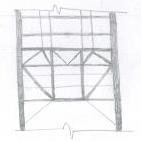-
Posts
517 -
Joined
-
Last visited
-
Days Won
278
Reputation Activity
-
 Badar (BAZ) got a reaction from UmarMakhzumi in Short term (cracked) deflection for cantilever slab in SAFE
Badar (BAZ) got a reaction from UmarMakhzumi in Short term (cracked) deflection for cantilever slab in SAFE
Yes, " nonlinear cracked" is ok. A part from that, you need to specify the source of reinforcement for cracked analysis in SAFE through "cracking analysis options".
How are you performing your manual calculations?
-
 Badar (BAZ) got a reaction from Thila in Short term (cracked) deflection for cantilever slab in SAFE
Badar (BAZ) got a reaction from Thila in Short term (cracked) deflection for cantilever slab in SAFE
Yes, " nonlinear cracked" is ok. A part from that, you need to specify the source of reinforcement for cracked analysis in SAFE through "cracking analysis options".
How are you performing your manual calculations?
-
 Badar (BAZ) reacted to UmarMakhzumi in Connection failure
Badar (BAZ) reacted to UmarMakhzumi in Connection failure
Good share. Looks like a concrete breakout failure.
Thanks.
-
 Badar (BAZ) got a reaction from abbaskhan2294 in Connection failure
Badar (BAZ) got a reaction from abbaskhan2294 in Connection failure
The video shows the concrete break-out failure of steel plate's connection with concrete wall . This is the case where a retrofit scheme has also failed.
-
 Badar (BAZ) got a reaction from Saugat Humagain in ETABS, Response Spectrum
Badar (BAZ) got a reaction from Saugat Humagain in ETABS, Response Spectrum
1. Since we need to know the behavior of building/structure in more than one direction, we load it in more than one direction.
2. Scaling is done to limit the force that is applied on building in ETABS.
3. It is related to first point.
-
 Badar (BAZ) got a reaction from Shahzad Khan in Connection failure
Badar (BAZ) got a reaction from Shahzad Khan in Connection failure
The video shows the concrete break-out failure of steel plate's connection with concrete wall . This is the case where a retrofit scheme has also failed.
-
 Badar (BAZ) got a reaction from Ayesha in SAP2000 Problem with building deformation from seismic load
Badar (BAZ) got a reaction from Ayesha in SAP2000 Problem with building deformation from seismic load
I am not sure what you mean by "middle of shear wall". Shouldn't shear wall serve as the support for beams anyways? Can't comment because I am not able to understand reason for your modelling-approach.
-
 Badar (BAZ) reacted to UmarMakhzumi in Raft Edges and Corners Overstressed
Badar (BAZ) reacted to UmarMakhzumi in Raft Edges and Corners Overstressed
Waqar,
You can change your column framing by adding more columns so load on edge columns is smaller than what you have now. Also review your load input and sharpen the pencil to see if there is any conservatism in the loads and take them out.
Thanks.
-
 Badar (BAZ) got a reaction from Shahzad Khan in Fixed Column Support
Badar (BAZ) got a reaction from Shahzad Khan in Fixed Column Support
It does according to the article 21.12.2.2 of ACI 318-11.
-
 Badar (BAZ) reacted to UmarMakhzumi in Beam-Girder Connection
Badar (BAZ) reacted to UmarMakhzumi in Beam-Girder Connection
This kind of connection is very common. What is the weight of the hoist/ trolley that would be running on the lower beam. The following things should be considered.
1) Include impact forces (vertical, longitudinal, and lateral) for design of beam as well as connection.
2) I suggest adding stiffener between the two bolts on each side of girder.
3) Deflection of bottom beam should be limited to L/600 or vendor criteria whichever is more stringent.
4) 12 mm bolts are very small. Generally we don't use less than 19mm (3/4" bolts). Bolts should be ASTM A325 or A490.
5) For hoists, bolts should be pretensioned. This is important.
Now, for designing such connection, you need to resolve the force at beam end for different position of hoists, the use the maximum value. You have 4 bolts, so calculate shear and tension for each bolt. Consider prying in your calculation. How to do the calculation is very simple. I don't have an example but you can get it from any text book on connection design.
Thanks.
-
 Badar (BAZ) reacted to EngrUzair in Design Snow Load
Badar (BAZ) reacted to EngrUzair in Design Snow Load
AA. Snowfall data of Murree, for the period from Jan 2017 to Mar 2020 has received. It is attached below for the information of all those interested. Data for the earlier period has already been uploaded in a previous post.
Regards.
-
 Badar (BAZ) got a reaction from Rifat in Cracked Section Requirement in Etabs
Badar (BAZ) got a reaction from Rifat in Cracked Section Requirement in Etabs
You got it all wrong. You have to consider cracked sections in your analysis irrespective of the need for the inclusion of P-delta effects.
If it is the case of compatibility torsion, then you don't need to consider full torsion.
-
 Badar (BAZ) got a reaction from Rifat in Cracked Section Requirement in Etabs
Badar (BAZ) got a reaction from Rifat in Cracked Section Requirement in Etabs
Yes, you not need to consider the effect of cracking in sections. Following is an excerpt from ASCE/SEI 7-16
"A mathematical model of the structure shall be constructed for the purpose of determining
member forces and structure displacements resulting from applied loads and any imposed displacements or P-delta
effects. The model shall include the stiffness and strength of elements that are significant to the distribution of forces and
deformations in the structure and represent the spatial distribution of mass and stiffness throughout the structure.
In addition, the model shall comply with the following:
a. Stiffness properties of concrete and masonry elements shall consider the effects of cracked sections."
ACI 318, or equivalent guidelines, set the rules. Use manual calculations/excel sheet to investigate your beams. A single modifier can not be applicable to every x-section of beam. It better to use a low modifier for all beams (0.1 or 0.01), and then manually verify only those cross-sections who are failing the shear+torsion interaction as per results of ETABS.
-
 Badar (BAZ) reacted to UmarMakhzumi in Seismic Frame Check
Badar (BAZ) reacted to UmarMakhzumi in Seismic Frame Check
W.Salaam,
For Dual Systems, frames of dual system are required to resist at-least 25% of the total base shear. This ensures that system has sufficient redundancy to justify the higher R value associated/ used with Dual Systems.
There are different way to do it. You can make a copy of your model (or do save as; whichever is more convenient). Assign stiffness modifiers to walls so that they would be taking gravity load only and analyse your model for 25% of total base shear. They other way would be to remove wall panels and just leave the boundary elements and analyse your model.
Thanks.
-
 Badar (BAZ) got a reaction from Abdullah Cheema in Stiffness Modifiers
Badar (BAZ) got a reaction from Abdullah Cheema in Stiffness Modifiers
The beam is a flexural member, and the column is an axial+flexural member. So, the beam will experience more cracking than columns. These numbers are deduced from experimental results ( read the commentary of ACI section 10.10.4.1).
-
 Badar (BAZ) got a reaction from UmarMakhzumi in Stiffness Modifiers
Badar (BAZ) got a reaction from UmarMakhzumi in Stiffness Modifiers
Both practices, with and without stiffness modifiers, are followed to decide about the reinforcement requirement against the design forces. Both approaches will lead to a stable structure as long as mechanics holds.
Having said that, the stiffness-modifier approach is more conservative, and is better representation of the actual conditions in most cases; one would expect columns to be less cracked than beams, and consequently will attract larger share of unbalanced moments at beam-column joint as compared to un-cracked scenario.
-
 Badar (BAZ) got a reaction from abbaskhan2294 in Stiffness Modifiers
Badar (BAZ) got a reaction from abbaskhan2294 in Stiffness Modifiers
Both practices, with and without stiffness modifiers, are followed to decide about the reinforcement requirement against the design forces. Both approaches will lead to a stable structure as long as mechanics holds.
Having said that, the stiffness-modifier approach is more conservative, and is better representation of the actual conditions in most cases; one would expect columns to be less cracked than beams, and consequently will attract larger share of unbalanced moments at beam-column joint as compared to un-cracked scenario.
-
 Badar (BAZ) got a reaction from UmarMakhzumi in RC gantry beam design
Badar (BAZ) got a reaction from UmarMakhzumi in RC gantry beam design
You need to use ACI 318's equation that relate service-level moment, or the moment against which you need to compute your deflection, to effective moment of inertia. The equation is 9-8 in versions before 318-14, and it is given in table 24.2.3.5 in the 2019 version of ACI . You shouldn't arbitrarily choose the factor.
-
 Badar (BAZ) got a reaction from abbaskhan2294 in Design of shear walls for Moment Envelop?
Badar (BAZ) got a reaction from abbaskhan2294 in Design of shear walls for Moment Envelop?
Concept of envelope is to find maximum value of design force (shear, moment, torsion) or displacement for a bunch of loading scenarios at various locations along the member.
Influence line is different. It gives you the value of force/displacement for a single point on a member for various positions of same loading type. Of course you can create envelope in this case as well.
-
 Badar (BAZ) got a reaction from UmarMakhzumi in ETABS: Thin Shell Vs Membrane
Badar (BAZ) got a reaction from UmarMakhzumi in ETABS: Thin Shell Vs Membrane
If the shell element has been designated as being membrane (in-plane behavior) , ETABS will not transfer out-of-plane loads.
-
 Badar (BAZ) got a reaction from UmarMakhzumi in Design of shear walls for Moment Envelop?
Badar (BAZ) got a reaction from UmarMakhzumi in Design of shear walls for Moment Envelop?
Concept of envelope is to find maximum value of design force (shear, moment, torsion) or displacement for a bunch of loading scenarios at various locations along the member.
Influence line is different. It gives you the value of force/displacement for a single point on a member for various positions of same loading type. Of course you can create envelope in this case as well.
-
 Badar (BAZ) got a reaction from UmarMakhzumi in Insertion Points and End Length Offsets in ETABs
Badar (BAZ) got a reaction from UmarMakhzumi in Insertion Points and End Length Offsets in ETABs
Yes, if you are using insertion points, do not use rigid links. I am more comfortable at using rigid links. Having said that, it will not make notable difference in most situations. Unless the eccentricity is more than 9 inches and there are long spans (more than 30ft).
-
 Badar (BAZ) got a reaction from Aye Min Khaing in Strong column weak beam design in etabs
Badar (BAZ) got a reaction from Aye Min Khaing in Strong column weak beam design in etabs
Etabs considers the rebar area that it suggests in calculating the capacity ratio. How else do you think one can calculate the moment capacity without considering reinforcement in members.
Yes, you need to check it manually based on the reinforcement prescribed in structural drawings.
-
 Badar (BAZ) got a reaction from callmeismail in Deck as Membrane.
Badar (BAZ) got a reaction from callmeismail in Deck as Membrane.
Membrane does not have bending stiffness, so it is useless to apply m11 and m22. As per my knowledge, ACI 318 or other codes that I know does prescribe any modifiers for this situations. I would use 0.35 for tension and 0.7 for compression to be applied to f11 or f22. Even 0.5 is not a bad choice
-
 Badar (BAZ) got a reaction from shazeb mirza in Structural Engineering Books
Badar (BAZ) got a reaction from shazeb mirza in Structural Engineering Books
Reinforced concrete structures, R. Park & T. Paulay
Design of Reinforced Concrete, Jack C. McCormac & James K. Nelson
Reinforced Concrete, Edward G. Nawy
Prestressed Concrete, Edward G. Nawy
Design of Prestressed Concrete, Arthur H. Nilson
Prestressed Concrete Analysis and Design, Antoine E. Naaman
Finite Element Procedures, Klaus-Jurgen Bathe
The Finite Element for Solid and Structural Mechanics, Zienkeiwicz & R.L. Taylor
Structural Analysis, Aslam Kassimali
Structural Analysis, R. C. Hibbeler
Theory of Elasticity, S. Timoshenko & J. N. Goodier
Seismic Design Of Reinforced Concrete And Masonry Buildings - T.Paulay,M.Priestley
FARZAD NAEIM HANDBOOK
Wind and EARTHQUAKE Resistant Buildings - Bungale S. Taranath
Dynamics of Structures, Anil K. Chopra
Structural Dynamics, Mario Paz.





